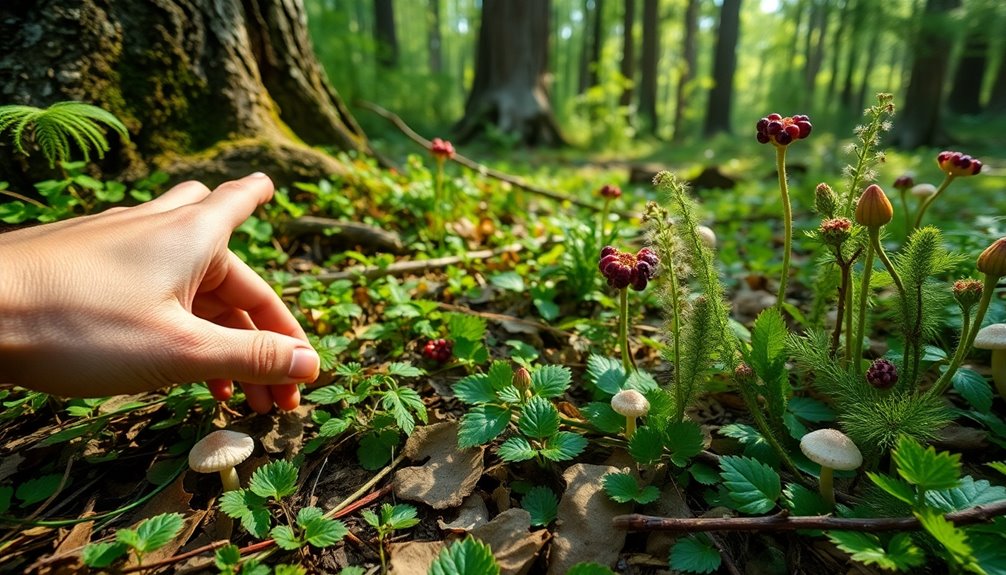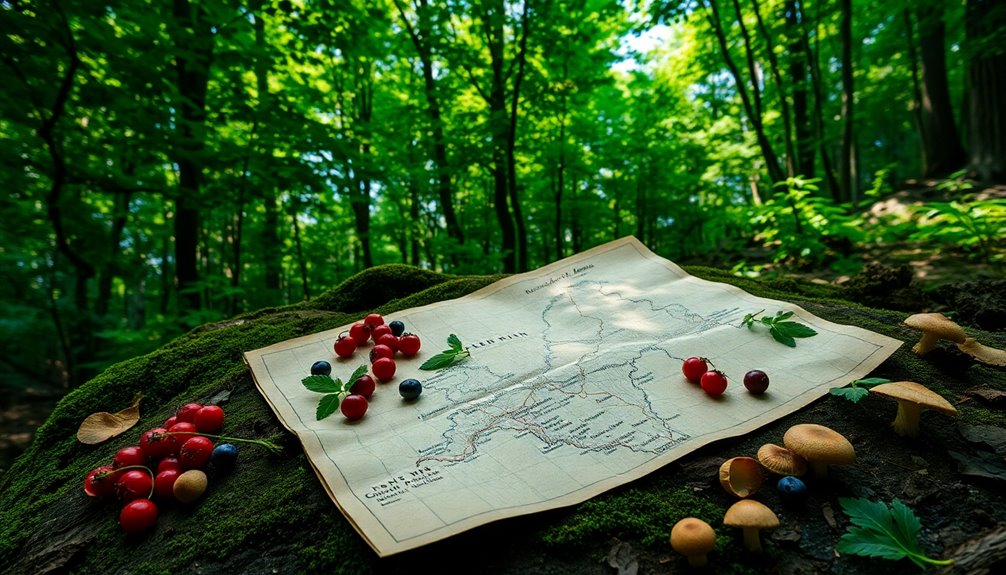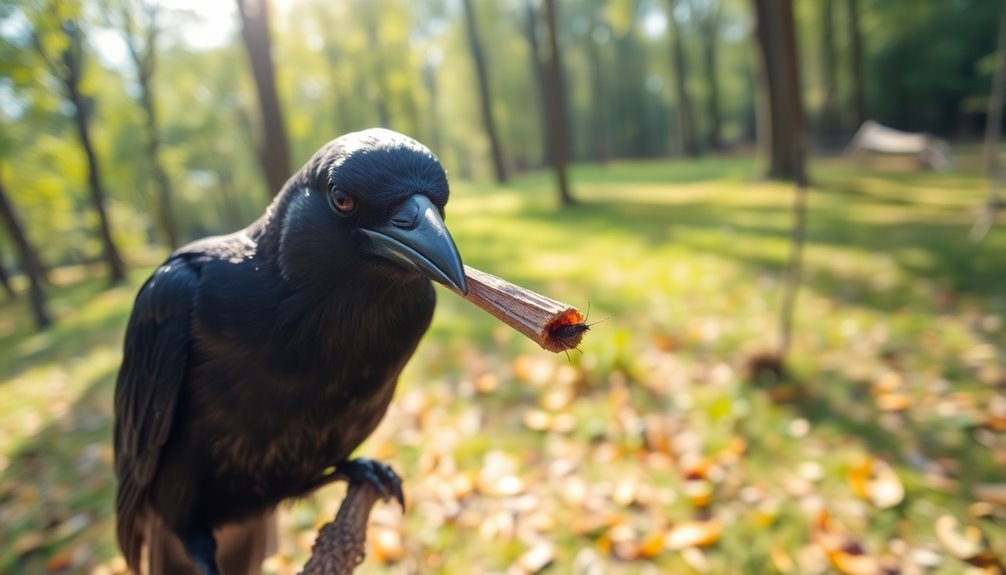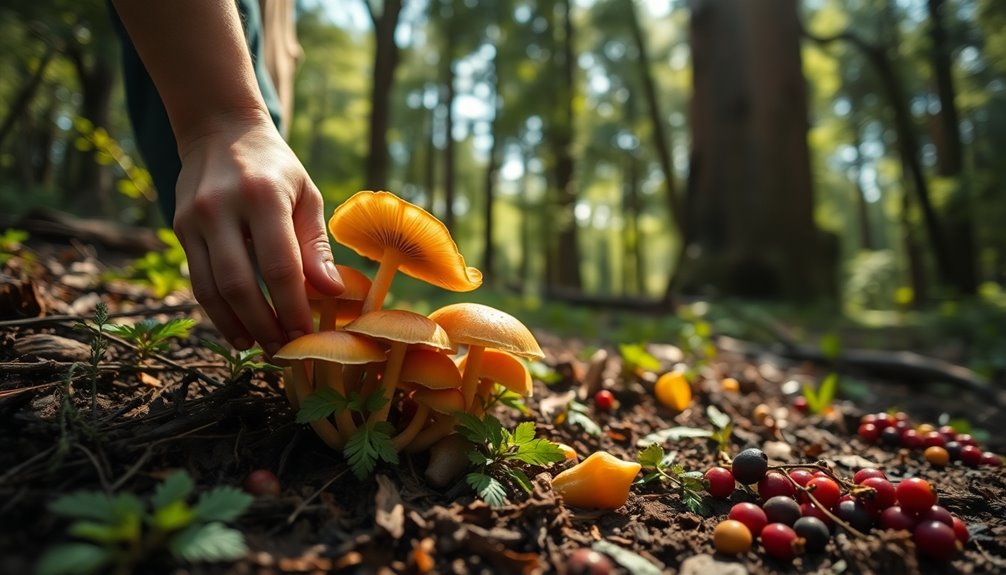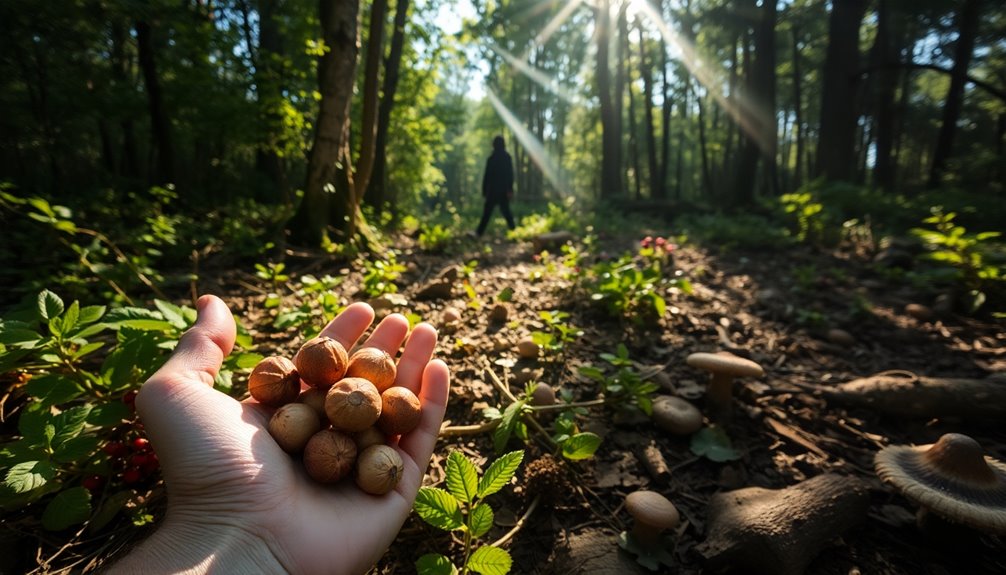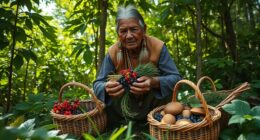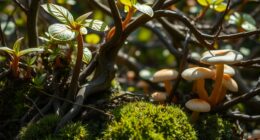Foraging, known as humanity's oldest cuisine, has its roots around 2 million years ago. It was the primary means of survival for early humans long before agriculture emerged about 12,000 years ago. Around 80,000 to 70,000 years ago, people began practicing more systematic foraging methods, enhancing food collection. Despite the rise of agriculture, foraging maintained its importance in various cultures, providing access to nutrient-rich foods. Today, modern foraging movements promote sustainable practices and community awareness, connecting people with nature. If you explore further, you'll uncover rich insights into foraging's impact on our diets and societies.
Key Takeaways
- Foraging practices date back approximately 2 million years, serving as the primary means of subsistence for early hominins.
- Systematic foraging began around 80,000 to 70,000 years ago, predating the development of agriculture.
- The transition to agriculture occurred around 10,000 years ago, but foraging continued to influence early civilizations.
- Foraging techniques evolved over time, incorporating specialized tools and seasonal gathering strategies to ensure food availability.
- Modern foraging movements emphasize sustainability and reconnecting with nature, reviving ancient practices in contemporary society.
Definition of Foraging
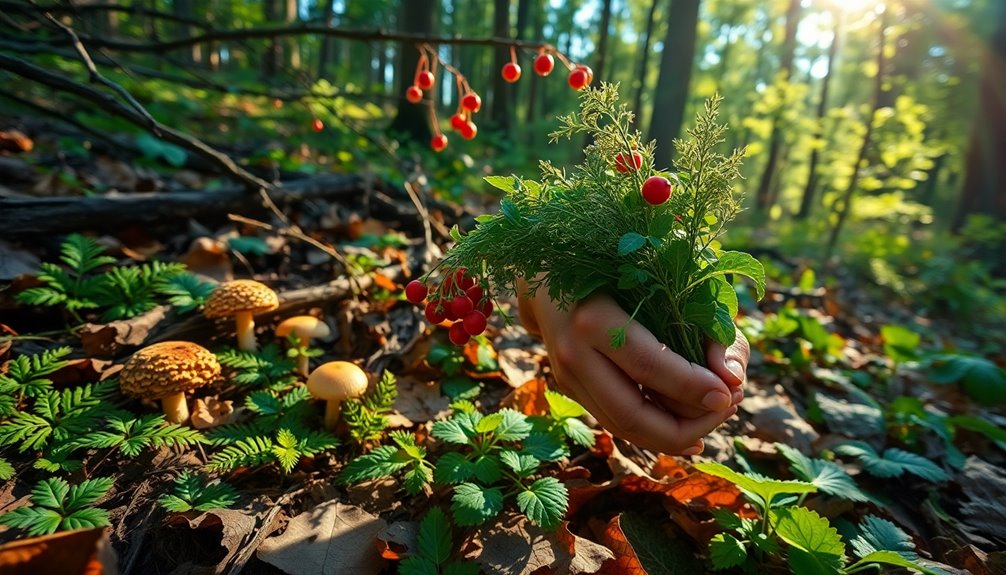
Foraging is the act of actively searching for and gathering wild food resources, such as plants, fruits, nuts, and small animals, to sustain human populations. It's a practice that's been around for about 2 million years, forming the basis of survival for early human societies.
Before agriculture emerged around 12,000 years ago, everyone relied on foraging to meet their nutritional needs.
As you explore foraging, you'll discover how hunter-gatherers embraced a diverse diet. They didn't just eat plants; insects and animal protein were also vital components of their meals.
You'll learn how these early foragers adapted their techniques based on seasonal changes and the unique ecosystems they inhabited. This adaptability was key to their survival.
Moreover, foraging wasn't just about food; it fostered social cohesion. Small, mobile groups shared knowledge, ensuring everyone knew the best sources of food.
Over time, foraging tools evolved, with baskets, digging sticks, and fishing nets increasing efficiency in gathering resources.
Understanding the definition of foraging gives you insight into the foundational practices that shaped human nutrition and social structures long before the rise of agriculture.
Historical Timeline of Foraging
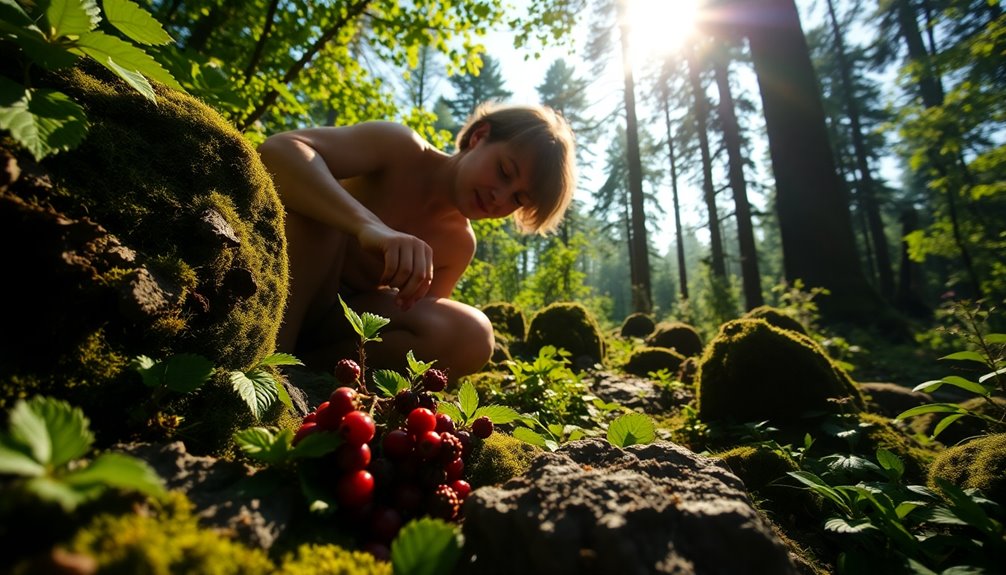
The practice of foraging has evolved considerably over the past 2 million years, tracing a fascinating journey through human history. Early hominins relied on foraging as their primary means of subsistence, scavenging for wild food sources.
Around 80,000 to 70,000 years ago, systematic foraging practices emerged with the development of specialized tools, making food gathering more efficient.
As you move through history, you'll see the Neolithic Revolution, starting about 12,000 years ago, marking a shift from foraging to agriculture.
However, many hunter-gatherer practices persisted, showcasing the resilience of foraging in human diets. Seasonal gathering of wild edible plants, nuts, and roots played a vital role in prehistoric diets, with evidence indicating that systematic harvesting evolved even before agriculture took hold.
Cultural Significance of Foraging

While many societies have shifted to agriculture, the cultural significance of foraging remains deeply rooted in human history and identity. For at least 2 million years, foraging has been a fundamental subsistence strategy, providing essential nutrition from wild plants, nuts, and roots.
Even with the Neolithic Revolution's onset 12,000 years ago, which introduced systematic food production, foraging didn't vanish. It continued to serve as a crucial dietary supplement for many communities.
In certain societies, especially among hunter-gatherers, foraging still holds immense cultural value. It's not just about survival; it's woven into their traditions, rituals, and social structures.
Modern foraging movements further highlight this cultural significance, encouraging individuals to reconnect with nature and rediscover traditional gathering methods. Urban foraging initiatives, for instance, promote awareness of local edible resources, bridging the gap between past practices and contemporary lifestyles. Additionally, some communities have embraced digital literacy programs to share knowledge about foraging techniques and safe practices.
Evolution of Foraging Techniques

As you explore the evolution of foraging techniques, you'll find that early gathering practices laid the foundation for more sophisticated methods.
Over time, foragers developed specialized tools that enhanced their efficiency in collecting food from various environments.
This progression not only reflects human ingenuity but also highlights the adaptability required to thrive in changing ecological landscapes.
Early Gathering Practices
Over 2 million years ago, early humans began to explore the diverse bounty of their environments through foraging. They relied on wild edible plants, insects, and small animals as primary food sources.
Gathering practices were initially seasonal; you'd find early humans collecting nuts and roots for preservation while consuming fresh produce immediately. This method guaranteed they'd have food available throughout the year.
As time passed, around 80,000 to 70,000 years ago, early humans developed specialized tools like fishing nets and gathering bags, which greatly enhanced their foraging efficiency. With these innovations, you can see how they became more adept at locating and harvesting food.
The Neolithic Revolution, occurring around 12,000 years ago, marked a critical change. Early humans began to adopt more systematic gathering, blending foraging practices with early agricultural signs. This shift laid the groundwork for future food systems.
Today, contemporary foraging techniques continue to evolve, driven by a renewed interest in sustainable and local food sources.
You might find that the essence of early gathering practices still resonates, reminding you of our deep-rooted connection to nature and the food we consume.
Tools and Techniques Evolution
The evolution of foraging tools and techniques marks a fascinating chapter in human history. About 2 million years ago, early hominins began using basic tools to assist in gathering wild plants and scavenging animal remains. This marks the beginning of tools and techniques evolution that shaped our ancestors' survival.
Fast forward to around 80,000 to 70,000 years ago, specialized tools like fishing nets and harpoons emerged, showcasing increased efficiency in gathering activities. You'll notice that gathering practices evolved to include seasonal foraging for nuts and roots, as well as berry gathering bags and rakes for fruits.
The shift from mere scavenging to active hunting and gathering highlighted significant advancements in human adaptability to diverse environments. As these tools became more sophisticated, they also carried cultural significance, reflecting their essential role in daily life and subsistence strategies.
The evolution of your foraging techniques ultimately underscores the ingenuity of early humans, paving the way for the diverse food practices we enjoy today.
Foraging vs. Agriculture

Foraging and agriculture represent two distinct yet interconnected approaches to food acquisition that have shaped human societies throughout history. Foraging, which involves gathering wild plants and hunting animals, dominated human sustenance for over 2 million years. It provided diverse, nutrient-rich options that supported early communities.
Then, around 12,000 years ago, the Neolithic Revolution transformed food production with agriculture, enabling systematic cultivation and permanent settlements.
Despite agriculture's rise, many societies still relied on foraging to enhance their diets. This highlights foraging's lasting importance, even in an age of farming. Today, foraging remains essential for underprivileged populations, offering access to wild foods that conventional agriculture may not provide.
While agriculture allows for greater food security and larger population densities, foraging promotes sustainability and a varied diet.
Both practices reflect the adaptability of human food-gathering strategies across different environments. Understanding the balance between foraging and agriculture reveals insights into our ancestors' survival and the ongoing relevance of these methods today.
As you explore these two approaches, consider how they've shaped not only our diets but also our cultures and lifestyles throughout history.
Modern Foraging Practices

In today's fast-paced world, modern foraging practices have emerged as a popular way to reconnect with nature and explore culinary creativity. As modern humans seek healthier lifestyles, foraging for wild edibles offers an exciting alternative to store-bought ingredients. Urbanites, in particular, are diving into this trend, using initiatives like the Incredible Edible movement in Todmorden, UK, as inspiration. This movement has sparked around 700 urban garden sites globally, encouraging communities to cultivate and share edible plants.
Foraging techniques have evolved considerably, with specialized tools like mushroom picking kits and berry gathering bags making it easier to collect wild foods. Many contemporary foragers focus on rediscovering forgotten plant varieties and incorporating them into their diets, reflecting a growing interest in sustainable and local food sources. In regions like Minnesota, foragers can find a rich variety of wild edibles such as wild leeks and blueberries, enhancing their culinary adventures.
While legal restrictions in protected areas can limit foraging activities, many urban dwellers continue to seek wild edibles in local parks and natural spaces. This blend of tradition and modernity not only fosters a deeper connection to the environment but also enhances culinary experiences, making foraging a fulfilling practice for today's society. Additionally, foragers are increasingly aware of the importance of sustainable food sources, ensuring that their practices do not deplete local ecosystems.
Regional Variations in Foraging
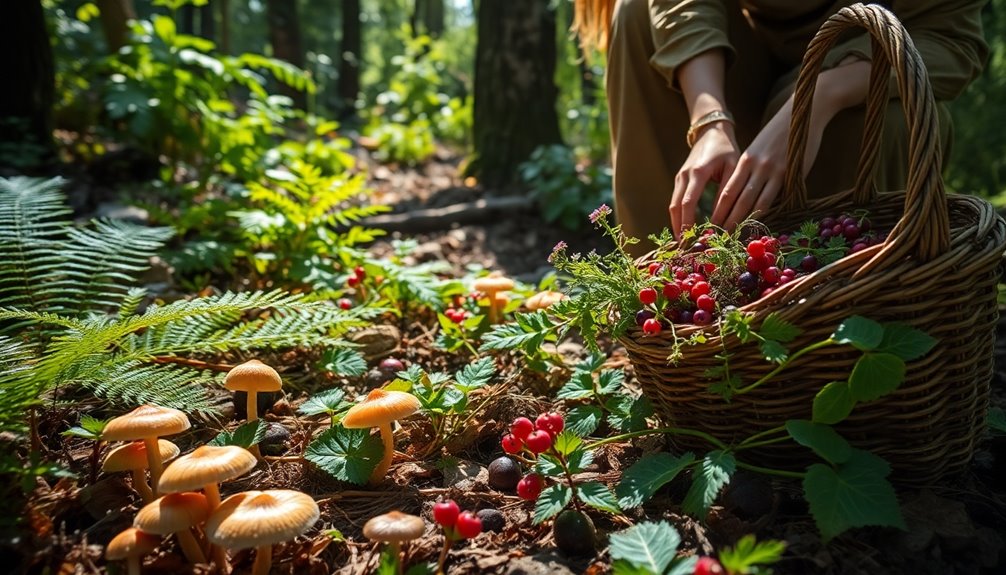
Modern foraging practices showcase the diverse ways people connect with their environment, but regional variations reveal even deeper insights into how communities adapt to their surroundings. Foraging practices differ markedly based on local climate, flora, and fauna, leading to unique dietary habits and techniques.
| Region | Foraging Practices |
|---|---|
| Temperate Zone | Seasonal fruits, nuts, and tubers; berry bags for gathering |
| Coastal Areas | Incorporation of fish and shellfish; use of fishing nets |
| Tropical Region | Wide range of edible plants; techniques like agroforestry |
| Arctic Areas | Specialized tools for hunting marine mammals; reliance on high-fat diets |
In temperate zones, you'll often find people gathering berries and nuts, while coastal foragers tap into marine resources. Tropical foragers utilize diverse edible plants and employ sustainable practices to enhance resource availability. In Arctic communities, like the Inuit, specialized hunting techniques highlight adaptation to harsh climates. These regional variations in foraging practices reflect not just the available resources but also the technological advancements communities develop to thrive in their specific environments. Understanding these differences enriches our appreciation for humanity's oldest cuisine. Additionally, the importance of sustainable practices in foraging cannot be overstated, as they ensure the longevity of these vital food sources for future generations.
Impact on Social Structures

The social structures of hunter-gatherer societies often break down traditional hierarchies, fostering a sense of community through shared resources. In these hunter-gatherer communities, everyone contributes to the group's survival, which promotes cooperation and reduces competition. Kinship plays a vital role, as relationships between members influence group dynamics and create strong support systems.
Leadership in these societies isn't permanent; it emerges situationally based on the group's immediate needs during hunting or gathering activities. This flexibility allows individuals to step forward when their skills are most valuable, reinforcing the community's adaptability.
Gender roles also challenge conventional views, as women actively participate in hunting alongside men, disproving the notion that large game hunting is solely a male activity. This shared responsibility fosters equality, further emphasizing an egalitarian social structure.
As specialization in hunting and gathering activities developed around 80,000 to 70,000 years ago, hunter-gatherer communities became more complex. The emergence of specialized tools not only enhanced efficiency but also influenced social interactions, encouraging collaboration among various skilled members.
Foraging and Sustainability

Foraging has shaped sustainable food systems throughout history, with early humans relying on seasonal practices to meet their nutritional needs.
Today, you can see a resurgence of modern gathering techniques that echo these historical methods, promoting ecological balance.
Historical Foraging Practices
Throughout history, people have relied on foraging to sustain themselves, gathering wild plants, insects, and game. Foraging practices date back over 2 million years, showcasing a deep-rooted connection to nature.
Here are some key aspects of historical foraging:
- Diverse Diet: Early humans thrived on a mix of nuts, roots, and edible plants, which formed the basis of their diet.
- Seasonal Gathering: Archaeological evidence shows that seasonal cycles dictated the availability of food, leading to efficient harvests.
- Shift to Agriculture: Around 11,000 years ago, systematic harvesting began, altering how humans procured food and paving the way for agriculture.
- Efficiency of Foraging: Research indicates that hunter-gatherers spent fewer hours working compared to agricultural workers, highlighting the leisurely aspects of foraging lifestyles.
These foraging practices not only sustained early communities but also laid the groundwork for future food systems. Additionally, understanding local regulations surrounding foraging is crucial for sustainable practices today.
Today, the emphasis on sustainable practices continues through initiatives like Incredible Edible, which advocate for community gardens and local food sourcing.
Modern Gathering Techniques
Today's foraging practices reflect a blend of traditional knowledge and modern innovation, showcasing a commitment to sustainability.
In modern times, you'll notice that gathering techniques have expanded beyond just wild plants to include small edible animals, like snails and seafood. This diverse approach enriches your foraging experience.
Specialized tools, such as mushroom picking kits and berry gathering bags, have emerged to enhance your efficiency while foraging in various environments.
You might also find urban foraging gaining popularity, with community initiatives like the Incredible Edible movement encouraging the cultivation of edible plants in public spaces. This promotes sustainable practices and fosters a sense of community.
Contemporary foragers often focus on rediscovering rare finds and forgotten plant varieties, supporting biodiversity and local ecosystems.
As you engage in these practices, you'll appreciate the cultural significance of gathering techniques, which highlight our connection to the natural environment.
Sustainable Food Systems
Embracing foraging as part of sustainable food systems can transform your relationship with nature and your diet. By incorporating foraging, you can:
- Access a diverse range of wild plants and animals that have fed humans for over 2 million years.
- Enhance food security by diversifying your diet and providing nutritional benefits, especially if fresh produce is scarce.
- Promote biodiversity by harvesting native species, which often require fewer resources than cultivated crops.
- Practice sustainable gathering techniques like selective harvesting, helping to preserve local ecosystems.
Foraging not only enriches your meals but also connects you to the land you live on. As you gather food, you'll notice how it encourages ecological balance and reduces the risk of overexploitation.
Modern movements, such as urban foraging and community gardens, reflect a growing desire to reconnect with nature and support local food systems. This shift fosters community engagement while ensuring that you're part of a sustainable food system.
Frequently Asked Questions
When Was Foraging Invented?
You might think of foraging as a simple way to find food, but it's actually a practice that dates back millions of years.
Early humans scavenged for resources before developing techniques for hunting and gathering. As you explore this ancient practice, you'll see how it evolved with tools like fishing nets.
Even today, foraging remains important, connecting you to the culinary traditions rooted in our prehistoric past.
It's a fascinating journey through human history!
Is the Oldest Form of Human Subsistence Is Foraging?
Yes, foraging is the oldest form of human subsistence.
You'll find that foraging has shaped our diets for millions of years, as people relied on gathering wild plants and hunting animals for survival. This practice required knowledge of the land and resources, allowing you to adapt to various environments.
Even today, foraging remains essential in many cultures, proving its enduring significance in human history and dietary practices.
Are All Humans Believed to Have Lived as Foragers Before 12000 Years Ago?
Did you know that for at least 90% of human history, you and your ancestors relied on foraging?
It's believed that all humans lived as foragers before 12,000 years ago. During this time, you hunted and gathered for food, which shaped your diet and lifestyle.
Even after agriculture emerged, many groups continued to forage, showing that this ancient practice remains a crucial part of human survival and cultural heritage.
Why Did Humans Begin Shifting From Foraging to Food Production 12,000 Years Ago?
Humans began moving from foraging to food production around 12,000 years ago due to several pressing factors.
As the climate changed and populations grew, you faced increasing pressure to guarantee food security. The change allowed you to exploit wild grains and domesticate plants and animals, leading to the establishment of permanent settlements.
This shift not only provided a more reliable food source but also spurred technological advances and greater social complexity in your communities.
Conclusion
In the grand tapestry of human history, foraging weaves a vibrant thread that connects us to our ancient ancestors. You've explored its evolution, from simple gathering to sophisticated techniques, and seen how it shapes cultures today. As you step outside, imagine yourself wandering through a sun-dappled forest, the scent of wild herbs filling the air, reminding you that the pursuit of food is not just about sustenance—it's a timeless dance with nature that continues to nourish our souls.

